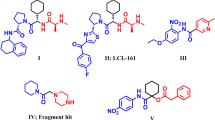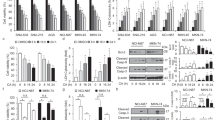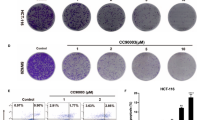Abstract
Aim:
To investigate the effects of a new derivative of bisphosphonates, [2-(6-aminopurine-9-yl)-1-hydroxy-phosphine acyl ethyl] phosphonic acid (CP), on human gastric cancer.
Methods:
Human gastric cancer cell lines (SGC-7901, BGC-823, MKN-45, and MKN-28) and human colon carcinoma cell lines (LoVo and HT-29) were tested. Cell growth was determined using the MTT assay. Flow cytometry, Western blot, caspase activity assay and siRNA transfection were used to examine the mechanisms of anticancer action. Female BALB/c nude mice were implanted with SGC-7901 cells. From d6 after inoculation, the animals were injected with CP (200 μg/kg, ip) or vehicle daily for 24 d.
Results:
CP suppressed the growth of the 6 human cancer cell lines with similar IC50 values (3239 μmol/L). In SGC-7901 cells, CP arrested cell cycle progression at the G2/M phase. The compound activated caspase-9, increased the expression of pro-apoptotic proteins Bax and Bad, decreased the expression of anti-apoptotic protein Bcl-2. Furthermore, the compound selectively activated ERK1/2 without affecting JNK and p38 in SGC-7901 cells. Treatment of SGC-7901 cells with the specific ERK1/2 inhibitor PD98059 or ERK1/2 siRNA hampered CP-mediated apoptosis. In the human gastric cancer xenograft nude mouse model, chronic administration of CP significantly retarded the tumor growth.
Conclusion:
CP is a broad-spectrum inhibitor of human carcinoma cells in vitro, and it also exerts significant inhibition on gastric cancer cell growth in vivo. CP induces human gastric cancer apoptosis via activation of the ERK1/2 signaling pathway.
Similar content being viewed by others
Log in or create a free account to read this content
Gain free access to this article, as well as selected content from this journal and more on nature.com
or
References
Boissier S, Ferreras M, Peyruchaud O, Magnetto S, Ebetino FH, Colombel M, et al. Bisphosphonates inhibit breast and prostate carcinoma cell invasion, an early event in the formation of bone metastases. Cancer Res 2000; 60: 2949–54.
Van Pluijm G, Vloedgraven H, van Beek E, van Wee-Pals L, Löwik C, Papapoulos S . Bisphosphonates inhibit the adhesion of breast cancer cells to bone matrices in vitro. J Clin Invest 1996; 98: 698–705.
Santini D, Vincenzi B, Dicuonzo G, Avvisati G, Massacesi C, Battistoni F, et al. Zoledronic acid induces significant and long-lasting modifications of circulating angiogenic factors in cancer patients. Clin Cancer Res 2003; 9: 2893–7.
Fromigue O, Lagneaux L, Body JJ . Bisphosphonates induce breast cancer cell death in vitro. J Bone Miner Res 2000; 15: 2211–21.
Lowe LC, Senaratne SG, Colston KW . Induction of apoptosis in breast cancer cells by apomine is mediated by caspase and p38 mitogen activated protein kinase activation. Biochem Biophys Res Commun 2005; 329: 772–9.
Verdidk R, Franke HR, Wolbers F, Vermes I . Differential effects of bisphosphonates on breast cancer cell lines. Cancer Lett 2007; 246: 308–12.
Gnant M, Mlineritsch B, Schippinger W, Luschin-Ebengreuth G, Postlberger S, Menzel C, et al. Endocrine therapy plus zoledronic acid in premenopausal breast cancer. New Engl J Med 2009; 360: 679–91.
Toru H, Paul JW, Gregory RM, Toshiyuki Y . The bisphosphonate ibandronate promotes apoptosis in MDA-MB-231 human breast cancer cells in bone metastases. Cancer Res 2001; 61: 4418–24.
Kiagia M, Karapanagiotou E, Charpidou A, Dilana K, Dionellis G, Dannos I, et al. Rapid infusion of ibandronate in lung cancer patients with bone metastases. Anticancer Res 2006; 26: 3133–6.
Bergner R, Henrich DM, Hoffmann M, Honecker A, Mikus G, Nauth B, et al. Renal safety and pharmacokinetics of ibandronate in multiple myeloma patients with or without impaired renal function. J Clin Pharmacol 2007; 47: 942–50.
Thaler R, Spitzer S, Karlic H, Berger C, Klaushofer K, Varga F . Ibandronate increases the expression of the pro-apoptotic gene FAS by epigenetic mechanisms in tumor cells. Biochem Pharmacol 2013; 85: 173–85.
Lipton A, Cook RJ, Major P, Smith MR, Coleman R . Zoledronic acid and survival in breast cancer patients with bone metastases and elevated markers of osteoclast activity. Oncologist 2007; 12: 1035–43.
Oura S, Hirai I, Yoshimasu T, Kokawa Y, Sasaki R . Clinical efficacy of bisphosphonate therapy for bone metastasis from breast cancer. Breast Cancer 2003; 10: 28–32.
Yamada J, Hirokazu NT, Kitayama J, Yoneyama S, Tsuchiya T, Asakage M, et al. Zoledronic acid inhibits gastric cancer cells by induction of apoptosis. AACR Meeting Abstracts 2006; 4: 895.
Trojana J, Kimb SZ, Engelsc K, Kriener S, Mitroub PS, Chowb KU . In vitro chemosensitivity to gemcitabine, oxaliplatin and zoledronic acid predicts treatment response in metastatic gastric cancer. Anticancer Drugs 2005; 16: 87–91.
Ye J, Cai LH, Li GL, Tai MC, inventors; Shijiazhuang GUOYU patent trademark office LTD, assignee, A adenyl-diphosphonate preparation method and its application in pharmaceutic preparation. China patent 200710185250.7, 2008 Apr 9.
Liu ZF, Chen CY, Tang W, Zhang JY, Gong YQ, Jia JH . Gene-expression profiles in gastric epithelial cells stimulated with spiral and coccoid Helicobacter pylori. J Med Microbiol 2006; 55: 1009–15.
Jiang C, Wang Z, Ganther H, Lu J . Caspases as key executors of methyl selenium-induced apoptosis (anoikis) of DU-145 prostate cancer cells. Cancer Res 2001; 61: 3062–70.
Han LL, Xie LP, Li LH, Zhang XW, Zhang RQ, Wang HZ . Reactive oxygen species production and Bax/Bcl-2 regulation in honokiol-induced apoptosis in human hepatocellular carcinoma SMMC-7721 cells. Environ Toxicol Pharmacol 2009; 28: 97–103.
Cory S, Adams JM . The Bcl2 family: regulators of the cellular life-or-death switch. Nat Rev Cancer 2002; 2: 647–56.
Kohno N, Aogi K, Minami H, Nakamura S, Asaga T, Iino Y, et al. Zoledronic acid significantly reduces skeletal complications compared with placebo in Japanese women with bone metastases from breast cancer: a randomized, placebo-controlled trial. J Clin Oncol 2005; 23: 3314–21.
Luckman SP, Hughes DE, Coxon FP, Russell RG, Rogers MJ . Nitrogen-containing bisphosphonates inhibit the mevalonate pathway and prevent post-translational prenylation of GTP binding proteins, including Ras. J Bone Miner Res 1998; 13: 581–9.
Van Beek E, Pieterman E, Cohen L, Lowik C, Papoulos C . Nitrogen-containing bisphosphonates inhibit isopentyl pyrophosphate isomerase/farnesyl pyrophosphate synthase activity with relative potencies corresponding to their antiresorptive potencies in vitro and in vivo. Biochem Biophys Res Commun 1999; 255: 491–4.
Shipman CM, Rogers MJ, Apperley JF, Russell RG, Croucher PI . Bisphosphonates induce apoptosis in human myeloma cell lines: a novel anti-tumour activity. Br J Haematol 1997; 98: 665–72.
Tassone P, Tagliaferri P, Viscomi C, Palmieri C, Caraglia M, D'Alessandro A, et al. Zoledronic acid induces antiproliferative and apoptotic effects in human pancreatic cancer cells in vitro. Br J Cancer 2003; 88: 1971–8.
Lee MV, Fong EM, Singer FR, Guenette RS . Bisphosphonate treatment inhibits the growth of prostrate cancer cells. Cancer Res 2001; 61: 2602–8.
Senaratne SG, Pirianov G, Mansi JL, Arnett TR, Colston KW . Bisphosphonates induce apoptosis in human breast cancer cell lines. Br J Cancer 2000; 82: 1459–68.
Pazianas M, Abrahamsen B, Eiken PA, Eastell R, Russell RG . Reduced colon cancer incidence and mortality in postmenopausal women treated with an oral bisphosphonate — Danish National Register Based Cohort Study. Osteoporos Int 2012; 23: 2693–701.
Bundred N . Antiresorptive therapies in oncology and their effects on cancer progression. Cancer Treat Rev 2012; 38: 776–86.
Rodrigues P, Hering FO, Meller A . Adjuvant effect of IV clodronate on the delay of bone metastasis in high-risk prostate cancer patients: a prospective study. Cancer Res Treat 2011; 43: 231–5.
Daubine F, LE Bot R, Marquez M, Nilsson S, Schroder T, Holmberg AR . Treatment of bone metastasis in prostate cancer: efficacy of a novel polybisphosphonate. Anticancer Res 2011; 31: 4141–5.
Murray AW . Recycling the cell cycle: cyclins revisited. Cell 2004; 116: 221–34.
Pietenpol JA, Stewart ZA . Cell cycle checkpoint signaling: cell cycle arrest versus apoptosis. Toxicology 2002; 181–182: 475–81.
Adams JM, Cory S . The Bcl-2 protein family: arbiters of cell survival. Science 1998; 281: 1322–6.
Mohanty IR, Arya DS, Gupta SK . Withania somnifera provides cardioprotection and attenuates ischemia-reperfusion induced apoptosis. Clin Nutr 2008; 27: 635–42.
Tamm I, Schriever F, Dorken B . Apoptosis: implications of basic research for clinical oncology. Lancet Oncol 2001; 2: 33–42.
Nicholson DW, Thornberry NA . Apoptosis. Life and death decisions. Science 2003; 299: 214–5.
Nicholson DW, Ali A, Thornberry NA, Vaillancourt JP, Ding CK, Gallant M . Identification and inhibition of the ICE/CED-3 protease necessary for mammalian apoptosis. Nature 1995; 376: 37–43.
Chang L, Karin M . Mammalian MAP kinase signalling cascades. Nature 2001; 410: 37–40.
Prashant KM, Narayana K, Neha S, Pushkar S . Interplay between MEK-ERK signaling, cyclin D1, and cyclin-dependent kinase 5 regulates cell cycle reentry and apoptosis of neurons. Mol Biol Cell 2012; 23: 3722–30.
Chambon JP, Soule J, Pomies P, Fort P, Sahuquet A, Alexandre D, et al. Tail regression in ciona intestinalis (prochordate) involves a caspase-dependent apoptosis event associated with ERK activation. Development 2002; 129: 3105–14.
Stefanelli C, Tantini B, Fattori M, Stanic I, Pignatti C, Clo C, et al. Caspase activation in etoposide-treated fibroblasts is correlated to ERK phosphorylation and both events are blocked by polyamine depletion. FEBS Lett 2002; 527: 223–8.
Tang D, Wu D, Hirao A, Lahti JM, Liu L, Mazza B, et al. ERK activation mediates cell cycle arrest and apoptosis after DNA damage independently of p53. J Biol Chem 2002; 277: 12710–7.
Kim GS, Hong JS, Kim SW, Koh JM, An CS, Choi JY, et al. Leptin induces apoptosis via ERK/cPLA2/cytochrome c pathway in human bone marrow stromal cells. J Biol Chem 2003; 278: 21920–9.
Yang R, Piperdi S, Gorlick R . Activation of the RAF mitogen-activated protein extracellular signal-regulated kinase kinase extracellular signal-regulated kinase pathway mediates apoptosis induced by chelerythrine in osteosarcoma. Clin Cancer Res 2008; 14: 6396–404.
Acknowledgements
This research was supported by the National Natural Science Foundation of China (No 81072033).
Author information
Authors and Affiliations
Corresponding author
Rights and permissions
About this article
Cite this article
Wang, Hj., Liu, Y., Fan, Lq. et al. A new bisphosphonate derivative, CP, induces gastric cancer cell apoptosis via activation of the ERK1/2 signaling pathway. Acta Pharmacol Sin 34, 1535–1544 (2013). https://doi.org/10.1038/aps.2013.103
Received:
Accepted:
Published:
Issue date:
DOI: https://doi.org/10.1038/aps.2013.103
Keywords
This article is cited by
-
New Medical/Biologic Paradigms in the Treatment of Bone Tumors
Current Surgery Reports (2014)



